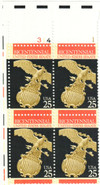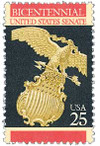
# 2413 - 1989 25c Constitution Bicentennial: United States Senate
U.S. #2413
1989 25¢ United States Senate
Constitution Bicentennial Series
- Issued on 200th anniversary of first formal session of US Senate
- Second stamp in Government Branches mini-series
- Pictures gilt eagle and shield hanging above the vice president’s chair in the Old Senate chamber
Stamp Category: Commemorative
Series: Constitution Bicentennial
Value: 25¢, first-class rate
First Day of Issue: April 6, 1989
First Day City: Washington, DC
Quantity Issued: 137,985,000
Printed by: Bureau of Engraving and Printing
Printing Method: Lithographed and engraved
Format: Panes of 50 in sheets of 200
Perforations: 11
Why the stamp was issued: As part of a series commemorating the 200th anniversary of the US Constitution. This was also the second stamp in a mini-series honoring the three branches of our government. It was issued on the 200th anniversary of the Senate’s first formal session, which took place on April 6, 1789, in Federal Hall, New York City.
About the stamp design: Howard Koslow based his stamp design on a wood and metal statue that sits above the vice president’s chair in the Old Senate Chamber of the US Capitol. The stamp is a closely cropped image of the gilt eagle with outstretched wings, a ribbon in its beak, and arrows in its talons. The eagle stands on a shield with the stars and stripes.
It's unknown who created the sculpture or when it was installed, but it was included in Capitol Architect Benjamin Henry Latrobe’s plans for the Senate chamber in 1809.
First Day City: The First Day Ceremony for this stamp was held in the Old Senate Chamber in the US Capitol in Washington, DC. The Senate used that chamber until 1859.
About the Constitution Bicentennial Series: This series was produced in 1989 and 1990 to commemorate the 200th anniversary the Constitution as well as our three branches of government it created. However, the USPS opted to do four stamps, so both chambers of Congress could have their own stamps. Both for political considerations and because they each have their own anniversary dates.
The three branches had previously been honored on stamps as part of a set honoring the 150th anniversary of the creation of the District of Columbia. That set pictured each of the buildings in which the operated. Early mockups for the Bicentennial stamps also included these buildings along with other recognizable symbols associated with the branches. The Citizens’ Stamp Advisory Committee felt that had been done enough times already and wanted to do something else. Eventually they settled on depictions of sculptural objects relating to each branch with a matching black and gold color scheme. Stamp artist Howard Koslow visited the US Capitol and Supreme Court and spoke to experts and historians about which subjects would be best for each stamp.
History the stamp represents: On March 4, 1789, the US Congress met for the first time under the terms of the recently ratified US Constitution.
In the spring of 1787, delegates from 12 of the 13 states (Rhode Island didn’t participate, as they opposed a national government) met at Independence Hall in Philadelphia to amend the Articles of Confederation. The Constitutional Convention opened on May 4.
The members of the convention ultimately drafted the new constitution based largely on the ideas of James Madison and signed it on September 17. In order for the proposed constitution to take effect, at least nine out of 13 states needed to ratify it. Five states ratified it that December, but some states, particularly Massachusetts, were unhappy with it. They felt the Constitution didn’t provide enough protection for freedom of speech, religion, the press, and the right to bear arms. In February 1788, they reached a compromise – those states would ratify the Constitution on the promise that amendments would be adopted to address their concerns. On June 21, 1788, New Hampshire became the ninth state to ratify the Constitution, making it legally binding.
On March 4, 1789, the Confederation Congress passed the power of the government over to the new US Congress operating under the Constitution. That day, the new Congress met for the first time at Federal Hall in New York City. During that session, James Madison also introduced the first draft of the Bill of Rights for consideration. But neither the House nor the Senate had enough members present to vote, and it would be a month before they all arrived. Finally, that September they agreed on the Bill of Rights and sent it to the states for ratification, which would take two years.
After this initial March 4 meeting, Congress moved the first day of business to December 1. However, March 4 would still hold special significance – it would be the last day of Congress’ two-year sessions. It would also be the day a new president was inaugurated. But as it turned out, this created some issues. Following a November election, Congress members that may have lost an election would have to continue to serve in a long “lame duck” session. On two occasions, lame-duck House sessions elected presidents (Thomas Jefferson in 1800 and John Quincy Adams in 1824). And in 1860, lame duck president James Buchanan and a divided Congress saw seven states secede from the Union after Abraham Lincoln was elected.
Eventually, the government realized the issues with the March 4 date. In 1933, they passed the 20th Amendment. This amendment set January 3 as the first day of a new Congress and January 20 as inauguration day for the president. It also stated the previous congressional and presidential terms would end just before the new ones began.
U.S. #2413
1989 25¢ United States Senate
Constitution Bicentennial Series
- Issued on 200th anniversary of first formal session of US Senate
- Second stamp in Government Branches mini-series
- Pictures gilt eagle and shield hanging above the vice president’s chair in the Old Senate chamber
Stamp Category: Commemorative
Series: Constitution Bicentennial
Value: 25¢, first-class rate
First Day of Issue: April 6, 1989
First Day City: Washington, DC
Quantity Issued: 137,985,000
Printed by: Bureau of Engraving and Printing
Printing Method: Lithographed and engraved
Format: Panes of 50 in sheets of 200
Perforations: 11
Why the stamp was issued: As part of a series commemorating the 200th anniversary of the US Constitution. This was also the second stamp in a mini-series honoring the three branches of our government. It was issued on the 200th anniversary of the Senate’s first formal session, which took place on April 6, 1789, in Federal Hall, New York City.
About the stamp design: Howard Koslow based his stamp design on a wood and metal statue that sits above the vice president’s chair in the Old Senate Chamber of the US Capitol. The stamp is a closely cropped image of the gilt eagle with outstretched wings, a ribbon in its beak, and arrows in its talons. The eagle stands on a shield with the stars and stripes.
It's unknown who created the sculpture or when it was installed, but it was included in Capitol Architect Benjamin Henry Latrobe’s plans for the Senate chamber in 1809.
First Day City: The First Day Ceremony for this stamp was held in the Old Senate Chamber in the US Capitol in Washington, DC. The Senate used that chamber until 1859.
About the Constitution Bicentennial Series: This series was produced in 1989 and 1990 to commemorate the 200th anniversary the Constitution as well as our three branches of government it created. However, the USPS opted to do four stamps, so both chambers of Congress could have their own stamps. Both for political considerations and because they each have their own anniversary dates.
The three branches had previously been honored on stamps as part of a set honoring the 150th anniversary of the creation of the District of Columbia. That set pictured each of the buildings in which the operated. Early mockups for the Bicentennial stamps also included these buildings along with other recognizable symbols associated with the branches. The Citizens’ Stamp Advisory Committee felt that had been done enough times already and wanted to do something else. Eventually they settled on depictions of sculptural objects relating to each branch with a matching black and gold color scheme. Stamp artist Howard Koslow visited the US Capitol and Supreme Court and spoke to experts and historians about which subjects would be best for each stamp.
History the stamp represents: On March 4, 1789, the US Congress met for the first time under the terms of the recently ratified US Constitution.
In the spring of 1787, delegates from 12 of the 13 states (Rhode Island didn’t participate, as they opposed a national government) met at Independence Hall in Philadelphia to amend the Articles of Confederation. The Constitutional Convention opened on May 4.
The members of the convention ultimately drafted the new constitution based largely on the ideas of James Madison and signed it on September 17. In order for the proposed constitution to take effect, at least nine out of 13 states needed to ratify it. Five states ratified it that December, but some states, particularly Massachusetts, were unhappy with it. They felt the Constitution didn’t provide enough protection for freedom of speech, religion, the press, and the right to bear arms. In February 1788, they reached a compromise – those states would ratify the Constitution on the promise that amendments would be adopted to address their concerns. On June 21, 1788, New Hampshire became the ninth state to ratify the Constitution, making it legally binding.
On March 4, 1789, the Confederation Congress passed the power of the government over to the new US Congress operating under the Constitution. That day, the new Congress met for the first time at Federal Hall in New York City. During that session, James Madison also introduced the first draft of the Bill of Rights for consideration. But neither the House nor the Senate had enough members present to vote, and it would be a month before they all arrived. Finally, that September they agreed on the Bill of Rights and sent it to the states for ratification, which would take two years.
After this initial March 4 meeting, Congress moved the first day of business to December 1. However, March 4 would still hold special significance – it would be the last day of Congress’ two-year sessions. It would also be the day a new president was inaugurated. But as it turned out, this created some issues. Following a November election, Congress members that may have lost an election would have to continue to serve in a long “lame duck” session. On two occasions, lame-duck House sessions elected presidents (Thomas Jefferson in 1800 and John Quincy Adams in 1824). And in 1860, lame duck president James Buchanan and a divided Congress saw seven states secede from the Union after Abraham Lincoln was elected.
Eventually, the government realized the issues with the March 4 date. In 1933, they passed the 20th Amendment. This amendment set January 3 as the first day of a new Congress and January 20 as inauguration day for the president. It also stated the previous congressional and presidential terms would end just before the new ones began.









